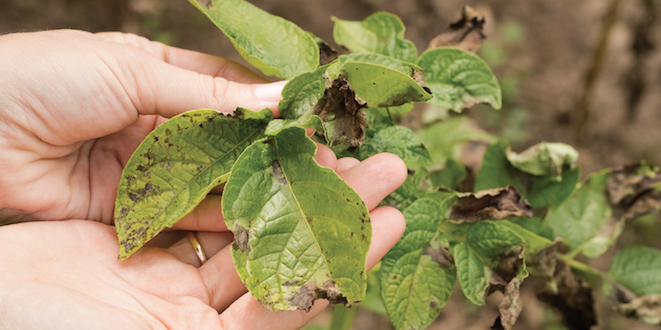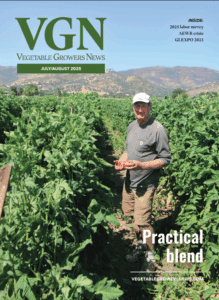
Jan 24, 2020Phytopthora control is a long-term commitment
Phytophthora can survive in the soil for more than 10 years, making control a long-term issue.
“If you have phytophthora in your fields, you’re looking at managing it as a chronic issue,” said Mary Hausbeck, vegetable pathologist in Michigan State University’s (MSU) Department of Plant, Soil and Microbial Sciences. “It will always be there.”
Warm temperatures and rain favor the disease. “Wetness and warm weather are the big, driving factors,” Hausbeck said. Phytophthora capsici isn’t spread by air movement. It’s caused by a water mold and the mold spores move in water.
Heavy rain splashing on contaminated soil can infect plants and the swath of phytophthora damage in a field often follows the path of moving water after a rain.
Irrigating with contaminated water is a frequent source of infection. Surface waters – rivers, creeks and ponds – are frequently contaminated with phytophthora. “Surface water can look as clear as bathing water and can be contaminated with phytophthora,” Hausbeck said. Contaminated surface waters can also move the pathogen downstream to other farms.
Disease symptoms on fruit can take a few days to appear after infection. Fruit can appear healthy at harvest and then develop disease symptoms during transit or on grocers’ shelves. The classic symptom of phytophthora is a white, powdered sugar appearance.
Cucurbits are especially susceptible. “Growers used to love a bell pepper/ cucumber rotation,” Hausbeck said, “and had to change because of phytophthora.” The rotation provided host crops that the phytophthora micro-organism could infect every year and the disease became very difficult to control. Crops this pathogen can infect include snap bean, pumpkin, squash, cucumber, pepper, tomato, watermelon, zucchini and cantaloupe.
Cucumber vines are somewhat tolerant to the disease while their fruits are especially susceptible and healthy vines can sometimes hide contaminated fruit.
Fungicide sprays should target the developing fruit in cucumbers and it can be difficult to penetrate the foliage to get good coverage. Reducing the plant population can improve fungicide coverage and ensure the fruit are protected.
Summer squash and zucchini are very susceptible to phytophthora and disease symptoms can appear on both the vines and the fruit.
Squash are a target
Squashes vary in their susceptibility to phytophthora.
Spaghetti squash, for example, is less susceptible. “Use raised beds, plastic mulch, limit irrigation and choose effective fungicides, and you can get along pretty well,” Hausbeck said. Acorn squash, on the other hand, is more susceptible.
“It’s hard to manage phytophthora in squash because in some cropping systems, the fruit lays on the ground in direct contact with the pathogen,” Hausbeck said.
The first three weeks of fruit formation are when squash is most susceptible to phytophthora. The fruit of some squash types become less susceptible after three weeks but fruits with this “age-related resistance” are not immune. The fruits also lose this resistance if they become wounded.
Winter squash and pumpkins are unique in that the roots, crowns, stems, leaves and fruits are all susceptible to the disease. However, blight symptoms usually aren’t seen on the leaves unless the weather is rainy for an extended time.
Some cultivars of peppers have been bred to be tolerant of phytophthora. “It won’t get you through the season,” Hausbeck said. “You’ll see some symptoms later on. Putting down plastic, using tolerant varieties and a fungicide treatment or two is an effective control program for peppers.”
Some phytophthora isolates vary in their ability to cause disease so cultivars with tolerance in some areas may not be tolerant in others.
Fungicide strategy essential
Preventative fungicide applications are a must. When growing in a contaminated site in a field, growers should be ready to treat early and often. Fungicide recommendations and fact sheets on different crops are available from MSU at www.veggies.msu.edu.
Choosing the right application method is critical. “It’s a soil pathogen,” Hausbeck said. “You must use a drip or a drench application where you get it down into the soil in order to keep the plants alive. Foliar sprays are needed to protect against fruit rot.” This means the products must be labeled for the particular application that is desired.
Rotate the fungicides used between products with different FRAC numbers (Fungicide Resistance Action Committee) to prevent resistance. FRAC numbers identify products with different modes of action and the numbers are on the product labels.
Resistance is an increasing problem. “On many farms, phytophthora has become resistant to Ridomil,” Hausbeck said.
The best way to prevent phytophthora is to avoid planting susceptible crops in fields with a history of the disease. Power wash equipment after it’s been used in infested fields to prevent spreading the disease.
Managing water in the field is key to managing phytophthora.
Planting into raised beds that are at least six inches high wherever possible and using black plastic mulch increase drainage away from the roots and crown. The black plastic also keeps fruit from direct contact with the soil. Putting plastic down can also prevent contaminated soil from splashing up on the crop.
Tiling and improved drainage will help. Only plant into well-drained areas and avoid low areas of the field.
Drip irrigation is always preferred. Minimize the use of overhead irrigation – especially during fruiting. Don’t irrigate with surface water.
Crop rotation with non-susceptible crops is always recommended and never dump diseased culls in the fields.
Scout regularly for phytophthora. Remove any diseased plants as soon as symptoms appear. “Destroy a border of healthy plants surrounding the diseased ones,” Hausbeck said, since the healthy-looking plants are probably already infected.
Harvest as early as possible and don’t let harvested fruit contact infested soil.
Moving production sites may not be a long-term solution. “Growers have bought new parcels without phytophthora, but over time phytophthora became a problem,” Hausbeck said. This may be from movement of contaminated soil via equipment.
Even the best management may still not get you through the season. “Even good practices can be overwhelmed by heavy rains,” Hausbeck said.
— Dean Peterson, VGN correspondent
















